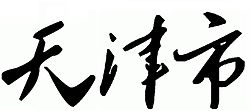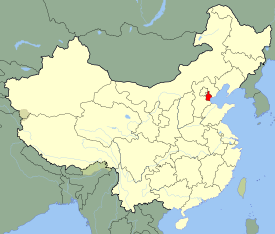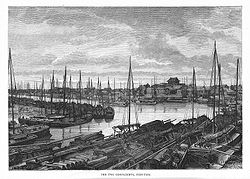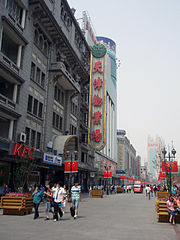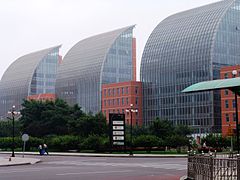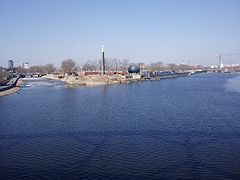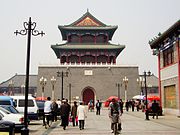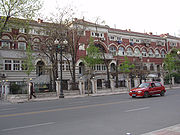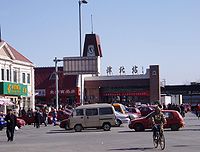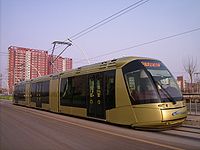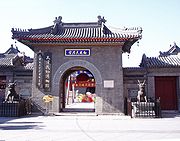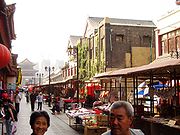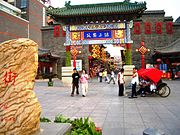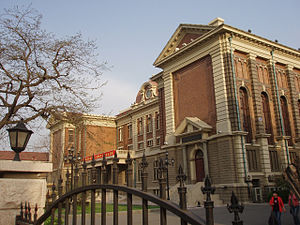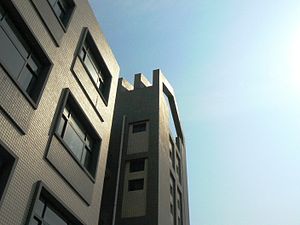
Tianjin
Background to the schools Wikipedia
SOS Children, an education charity, organised this selection. Click here to find out about child sponsorship.
| Municipality of Tianjin 天津市 |
|
|---|---|
| — Municipality — | |
| Chinese transcription(s) | |
| • Mandarin (Pinyin) | Tiānjīn |
| A view of Hedong District | |
| Location within China | |
| Coordinates: 39°8′N 117°11′E | |
| Country | |
| County-level divisions | 18 |
| Township divisions | 240 |
| Settled | ca. 340 BC |
| Government | |
| • CPC Municipal Secretary | Zhang Gaoli |
| • Mayor | Huang Xingguo |
| Area( ranked 30th) | |
| • Total | 11,760 km2 (4,540 sq mi) |
| Population (2007) | |
| • Total | 11,519,000 |
| • Density | 980/km2 (2,500/sq mi) |
| • Ranks in China | Population: 27th; Density: 12th |
| • Major nationalities | Han - 97% Hui - 2% Manchu - 0.6% |
| Time zone | China Standard Time ( UTC+8) |
| Postal code | 300000 - 301900 |
| Area code(s) | 22 |
| License plate prefixes | 津A, B, C, D, F, G, H 津E (taxis) |
| ISO 3166-2 | CN-12 |
| GDP (2007) | CNY 501.8 billion ( 20th) |
| - per capita | CNY 45,829 ( 3rd) |
| HDI (2005) | 0.855 ( 3rd) — high |
| City flower | Chinese rose (Rosa chinensis) |
| Website | (Chinese) www.tj.gov.cn (English) www.tj.gov.cn/english |
Tianjin (Chinese: 天津; pinyin: Tiānjīn; Postal map spelling: Tientsin) is a large city in northern coastal China. Administratively it is a municipality that has provincial-level status, reporting directly to the central government. Its urban area is the third largest in China, ranked only after Shanghai and Beijing.
Tianjin's urban area is located along the Hai He River. Its ports, some distance away, are located on Bohai Gulf in the Pacific Ocean. Tianjin was once home to foreign concessions in the late Qing Dynasty and early Republican era. The municipality now incorporates the coastal region of Tanggu, home to the Binhai New Area and the TEDA economic development zone. Tianjin Municipality borders Hebei province to the north, south, and west; the municipality of Beijing is to the northwest, and Bohai Gulf to the east.
History
The land where Tianjin lies today was created in historical times by sedimentation of various rivers entering the sea at Bohai Bay(渤海灣), including the Yellow River, which entered the sea in this area at one point.
The opening of the Grand Canal of China during the Sui Dynasty prompted the development of Tianjin into a trading centre. Until 1404, Tianjin was called "Zhigu" (直沽), or "Straight Port". In that year, the Emperor Yongle renamed the city Tianjin, literally "Heavenly Ford", to indicate that the Emperor (son of heaven) forded the river at that point. This is because he had indeed forded the river at Tianjin while on a campaign to wrest the throne from his nephew. A fort was established at Tianjin, known as "Tianjin Wei" ( simplified Chinese: 天津卫; traditional Chinese: 天津衛; pinyin: Tiānjīnwèi), meaning "Fort Tianjin".
Tianjin was promoted to a prefecture in 1725. Tianjin County was established under the prefecture in 1731.
In 1856, Chinese soldiers boarded The Arrow, a Chinese-owned ship registered in Hong Kong flying the British flag and suspected of piracy, smuggling and of being engaged in the opium trade. They captured 12 men and imprisoned them. In response, the British and French sent gunboats under the command of Admiral Sir Michael Seymour to capture the Taku forts (大沽砲臺) near Tianjin in May 1858. At the end of the first part of the Second Opium War in June of the same year, the Treaties of Tianjin were signed, which opened Tianjin to foreign trade. The treaties were ratified by the Emperor of China in 1860, and Tianjin was formally opened to the outside world. Between 1895 and 1900, Britain and France were joined by the empires of Japan, Germany and Russia, and even by countries without other Chinese concessions such as Austria-Hungary, Italy and Belgium, in establishing self-contained concessions in Tianjin, each with its own prisons, schools, barracks and hospitals.
The presence of foreign influence in Tianjin was not always peaceful; one of the most serious violent incidents to take place was the Tianjin Church Incident (天津教案). In June 1870, Wanghailou Church (T: 望海樓教堂 / S: 望海楼教堂) in Tianjin, built by French Roman Catholic missionaries one year earlier, was implicated in the kidnapping, death by neglect, and improper burial of Chinese children. It was said in the Chinese population that nuns were making preserves of children's eyes (it seems that the confusion came from jars of pickled small onions seen in the kitchen). On June 21, the magistrate of Tianjin County initiated a showdown at the church that developed into violent clashes between the church's Christian supporters and non-Christian Tianjin residents. The furious protestors eventually burned down Wanghailou Church and the nearby French consulate. After the incident, France and six other Western nations complained to the Qing government, which was forced to pay compensation for the incident.
In June 1900, the Boxers were able to seize control of much of Tianjin. On June 26, belligerent European forces heading towards Beijing were stopped by Boxers at nearby Langfang, and were defeated and forced to turn back to Tianjin. The foreign concessions also came under siege for several weeks.
In July 1900, the Eight Nation United Army attacked and occupied Tianjin. They soon established the Tianjin Provisional Government, composed of representatives from each of the occupying forces (Russian, British, Japanese, German, French, American, Austro-Hungarian, and Italian). Tianjin was governed by this council until August 15, 1902 when the city was returned to Qing control. Eminent Qing General Yuan Shikai headed efforts to remake Tianjin into a modern city, establishing the first modern Chinese police force here.
Tianjin was established as a municipality of China(直轄市) in 1927.
Western nations were permitted to garrison the area to ensure open access to Peking. The British maintained a brigade of two battalions there, and the Italians, French, Japanese, Germans, Russians, and Austro-Hungarians maintained understrength regiments; the United States did not initially participate. During World War I, the German and Austro-Hungarian garrisons were captured and held as Prisoners of War by Allied Forces while the Bolshevik government withdrew the Russian garrison in 1918. In 1920, the remaining participating nations asked the United States to join them, and the US then sent the 15th Infantry Regiment, less one battalion, to Tientsin from the Philippines.
Garrison duty was highly regarded by the troops. General George C Marshall, the "architect of victory" in World War II when he was the United States Army Chief of Staff, served at Tientsin in the 1920's as Executive Officer of the 15th Infantry. The US withdrew this unit in 1938 and a US presence was maintained only by the dispatch of a small US Marine Corps contingent from the Embassy Guard at Peking.
On July 30, 1937, Tianjin fell to Japan, as part of the Second Sino-Japanese War, but was not entirely occupied, as the Japanese for the most part respected foreign concessions until 1941, when the American and British concessions were occupied. In the summer of 1939, there occurred a major crisis in Anglo-Japanese relations with the Tientsin Incident. On June 14, 1939, the Imperial Japanese Army surrounded and blockaded the British concession over the refusal of the British authorities to hand over to the Japanese six Chinese who had assassinated a locally prominent Japanese collaborator, and had taken refuge in the British concession. For a time, the 1939 crisis appeared likely to cause an Anglo-Japanese war, especially when reports of the maltreatment by the Japanese Army of British subjects wishing to leave or enter the concession appeared in the British press. The crisis ended when the British Prime Minister Neville Chamberlain was advised by the Royal Navy and the Foreign Office that the only way to force the Japanese to lift the blockade was to send the main British battle fleet to Far Eastern waters, and that given the current crisis in Europe that it would be inappropriate to send the British fleet out of European waters, thus leading the British to finally turn over the six Chinese, who were then executed by the Japanese. During the Japanese occupation, Tianjin was ruled by the North China Executive Committee, a puppet state based in Beijing.
On August 9, 1940, all of the British troops in Tianjin were ordered to withdraw. On November 14, 1941 the American Marine unit stationed in Tianjin was ordered to leave, but before this could be accomplished, the Japanese attacked the United States. The small 47 man American Marine detachment surrendered to the Japanese on December 8, 1941. Only the Italian and French concessions (the local French officials were loyal to Vichy) were allowed to continue by the Japanese. Japanese occupation lasted until August 15, 1945, the surrender of Japan marking the end of World War II.
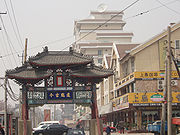
After 1945, Tianjin became base to American forces. In December 1946, the rape of a Beiping (北平)(now Beijing(北京)) female university student by an American soldier, together with a series of rapes that had previously occurred in Tianjin, sparked protests in Tianjin that culminated in a demonstration on January 1, 1947, involving thousands of students. American troops pulled out of Tianjin in June 1947.
Communist forces took Tianjin on January 15, 1949, following a 29-hour long battle. After the communist takeover, Tianjin remained a municipality of China, except between 1958 and 1967, when it became part of Hebei province and its capital. The Tangshan earthquake of 1976 killed 23,938 people in Tianjin and wrought heavy damage on the city.
After China began to open up in the late 1970s, Tianjin has seen rapid development, though it is now lagging behind other important cities like Shanghai, Beijing, and Guangzhou. Tianjin is now home to the Binhai New Area, a Pudong-like special economic zone that is supposed to balance out Shanghai's obvious commercial superiority.
Geography
Tianjin is at the northern end of the Grand Canal of China(大運河), which connects with the Huang He (黃河)and Yangtze (長江)rivers.
Tianjin Municipality is generally flat, and swampy near the coast, but hilly in the far north, where the Yanshan Mountains (燕山)pass through the tip of northern Tianjin. The highest point in Tianjin is Jiushanding Peak on the northern border with Hebei, at an altitude of 1078 m.
The Hai He River(海河) forms within Tianjin Municipality at the confluence of the Ziya River(子牙河), Daqing River(大清河), Yongding River(永定河), North Grand Canal, and South Grand Canal; and enters the Pacific Ocean at Tianjin Municipality as well, in Dagu District. Major reservoirs include the Beidagang Reservoir in the extreme south (in Dagang District) and the Yuqiao Reservoir in the extreme north (in Ji County).
The urban area of Tianjin is found in the south-central part of the Municipality. In addition to the main urban area of Tianjin proper, the coast along the Bohai is lined with a series of port towns, including Tanggu (塘沽)and Hangu(漢沽).
Tianjin's climate is a monsoon-influenced humid continental climate (Koppen climate classification Dwa) characterized by hot, humid summers, due to the monsoon, and dry, cold winters, due to the Siberian anticyclone. Average highs in January and July are 2 °C (36 °F) and 31 °C (87 °F) respectively). Spring is windy but dry, and most of the precipitation takes place in July and August. Tianjin also experiences occasional spring sandstorms which blow in from the Gobi Desert and may last for several days.
Administrative divisions
Tianjin is divided into 18 county-level divisions, including 15 districts and 3 counties. Six of the districts govern the urban area of Tianjin:
- Heping District ( Simplified Chinese: 和平区; Hanyu Pinyin: Hépíng Qū)
- Hexi District (河西区 Héxī Qū)
- Hebei District (河北区 Héběi Qū)
- Nankai District (南开区 Nánkāi Qū)
- Hedong District (河东区 Hédōng Qū)
- Hongqiao District (红桥区 Hōngqiáo Qū)
Three of the districts govern towns and harbours along the seacoast:
- Tanggu District (塘沽区 Tánggū Qū)
- Hangu District (汉沽区 Hàngū Qū)
- Dagang District (大港区 Dàgǎng Qū)
- These districts collectively make up the economic development zone of Binhai.
Four of the districts govern satellite towns and rural areas close to the urban centre:
- Jinnan District (津南区 Jīnnán Qū)
- Dongli District (东丽区 Dōnglì Qū)
- Xiqing District (西青区 Xīqīng Qū)
- Beichen District (北辰区 Běichén Qū)
Two of the districts as well as the three counties govern towns and rural areas further away from the urban centre:
- Baodi District (宝坻区 Bǎodǐ Qū) — Baodi County before 2001
- Wuqing District (武清区 Wǔqīng Qū) — Wuqing County before 2000
- Ji County (蓟县 Jì Xiàn)
- Jinghai County (静海县 Jìnghǎi Xiàn) (Chinese)
- Ninghe County (宁河县 Nínghé Xiàn)
In addition, the Tianjin Economic and Technological Development Area (TEDA) is not a formal level of administration, but nevertheless enjoys rights similar to a regular district.
These districts and counties are further subdivided, as of December 31, 2004, into 240 township-level divisions, including 120 towns, 18 townships, 2 ethnic townships and 100 subdistricts.
Politics
The politics of Tianjin is structured in a dual party-government system like all other governing institutions in the mainland China.
The Mayor of Tianjin is the highest ranking official in the People's Government of Tianjin. Since Tianjin is a centrally administered municipality, the mayor occupies the same level in the order of precedence as provincial governors. However, in the city's dual party-government governing system, the mayor has less power than the Tianjin Communist Party of China Municipal Committee Secretary, colloquially termed the "Tianjin CPC Party chief".
Economy
The nominal GDP for Tianjin was 501.8 billion yuan (US$66 billion) in 2007, a year-on-year increase of 15.1%.
In 2007, per capita GDP was 45,829 yuan. The manufacturing sector was the largest (57.6%) and fastest-growing (16.5%) sector of Tianjin's economy. Urban disposable income per capita was 16,357 yuan, a real increase of 14.5% from the previous year. Rural pure income per capita was 8,752 yuan, a real increase of 10.2% from the previous year.
Farmland takes up about 40% of Tianjin Municipality's total area. Wheat, rice, and maize are the most important crops. Fishing is important along the coast. Tianjin is also an important industrial base. Major industries include petrochemical industries, textiles, car manufacturing, mechanical industries, and metalworking.
Tianjin Municipality also has deposits of about 1 billion tonnes of petroleum, with Dagang District containing important oilfields. Salt production is also important, with Changlu Yanqu being one of China's most important salt production areas. Geothermal energy is another resource of Tianjin. Deposits of manganese and boron under Tianjin were the first to be found in China.
EADS Airbus will be opening an assembly plant for its A320 series airliners, to be operational in 2009. AVIC I and AVIC II will be EADS' local partners for the site, to which subassemblies will be sent from plants around the world.
Demographics
At the end of 2007, the population of Tianjin Municipality was 11.15 million, of which 9.59 million were holders of Tianjin hukou (permanent residence). Among Tianjin permanent residents, 5.8 million were urban, and 3.79 million were rural.
The majority of Tianjin residents are Han Chinese. Minorities include Hui, Koreans, Manchus, and Mongols.
| Ethnic groups in Tianjin, 2000 census | ||
|---|---|---|
| Nationality | Population | Percentage |
| Han | 9,581,775 | 97.29% |
| Hui | 172,357 | 1.75% |
| Manchu | 56,548 | 0.57% |
| Mongol | 11,331 | 0.12% |
| Korean | 11,041 | 0.11% |
| Zhuang | 4055 | 0.041% |
| Tujia | 3677 | 0.037% |
Excludes members of the People's Liberation Army in active service.
Source: Department of Population, Social, Science and Technology Statistics of the National Bureau of Statistics of China (國家統計局人口和社會科技統計司) and Department of Economic Development of the State Ethnic Affairs Commission of China (國家民族事務委員會經濟發展司), eds. Tabulation on Nationalities of 2000 Population Census of China (《2000年人口普查中國民族人口資料》). 2 vols. Beijing: Nationalities Publishing House (民族出版社), 2003. (ISBN )
Culture
People from urban Tianjin speak Tianjin dialect, which comes under the Mandarin subdivision of spoken Chinese. Despite its proximity to Beijing, Tianjin dialect sounds quite different from Beijing dialect, which provides the basis for Putonghua, official spoken language of the People's Republic of China.
Tianjin cuisine places a heavy focus on seafood, due to Tianjin's proximity to the sea. Prominent menus include the Eight Great Bowls (八大碗), a combination of eight mainly meat dishes. It can be further classified into several varieties, including the rough (粗), smooth (S: 细 / T: 細), and high (高). The Four Great Stews (四大扒) refers actually to a very large number of stews, including chicken, duck, seafood, beef, and mutton.
Tianjin also has several famous snack items. Goubuli (狗不理包子) is a traditional brand of baozi(包子) (steamed buns with filling) that is famous throughout China. Guifaxiang (S: 桂发祥麻花 / T: 桂發祥麻花) is a traditional brand of mahua (麻花)(twisted dough sticks). Erduoyan (耳朵眼炸糕) is a traditional brand of fried rice cakes.
Tianjin is a respected home base of Beijing opera, one of the most prestigious forms of Chinese opera.
Ma Sanli (馬三立)(1914 - 2003), an ethnic Hui and longtime resident of Tianjin, is paramountly respected in China for his xiangsheng(相聲), a hugely popular form of Chinese entertainment similar to stand-up comedy. Ma Sanli delivered some of his xiangsheng in the Tianjin dialect(天津話).
Yangliuqing (Green Willows), a town about 15 km west of Tianjin's urban area and the seat of Tianjin's Xiqing District, is famous for its popular Chinese New Year-themed, traditional-style, colourful wash paintings (楊柳青年畫). Tianjin is also famous for Zhang's clay figurines (S: 泥人张 / T: 泥人張) which are a type of colourful figurine depicting a variety of vivid characters, and Tianjin's Wei's kites (S: 风筝魏 / T: 風箏魏), which can be folded to a fraction of their full sizes, are noted for portability.
Stereotypes
People from Tianjin are stereotyped to be eloquent, humorous, open, and unfettered. There is a term for the stereotype of the always-eloquent and sometimes-humorous Tianjin native: wèizuǐzi (S: 卫嘴子 / T: 衛嘴子), which translates roughly as "the Tianjin mouth". This stereotype is perhaps partially the result of Ma Sanli's reputation (see "Culture" section above).
Transportation
Metro
The Tianjin Metro is currently under heavy expansion from 3 lines to 9 lines. 3 lines are currently operating both in the city and the Binhai
Rail
There are several railway stations in the city, Tianjin Railway Station being the principal one. It was built in 1888, initially, the station was located at Wangdaozhuang (S: 旺道庄 / T: 旺道莊). The station was later moved to Laolongtou (S: 老龙头 / T: 老龍頭) on the banks of the Hai He River in 1892, so the station was renamed Laolongtou Railway Station. The station was rebuilt from scratch in 1988. The rebuilding work began on April 15, 1987 and was finished on October 1, 1988. The Tianjin Railway Station is also locally called the 'East Station', due to its geographical position. In January 2007 the station began another long-term restructuring project to modernize the facility and as part of the larger Tianjin transportation hub project involving Tianjin metro lines 2, 3, and 9 as well as the Tianjin-Beijing High-speed rail.
Tianjin West Railway Station and Tianjin North Railway Station are also major railway stations in Tianjin. There is also Tanggu Railway Station is located in the important port area of Tanggu District, and TEDA Railway Station located in TEDA, to the north of Tanggu. There are several other railway stations in the city that do not handle passenger traffic.
Construction on a Beijing-Tianjin high-speed rail began on July 4, 2005, and is scheduled to be completed by August 2008.
The following rail lines go through Tianjin:
- Jingshan Railway, from Beijing to Shanhai Pass
- Jinpu Railway, from Tianjin to Pukou District, Nanjing
- Jinji Railway, from Tianjin urban area to Ji County, Tianjin
- Jinba Railway, from Tianjin to Bazhou, Hebei
Starting from Aug. 1, 2008, all trains stopping at the previous Tianjin Temporary Passenger Station will now instead use the newly completed Tianjin Railway Station.
Also, the inter-city trains between Beijing and Tianjin will adopt a new numbering system: Cxxxx (C stands for City in Chinese). The train numbers range between C2001~C2298:
- C2001~C2198: From Beijing South Station to Tianjin, non-stop.
- C2201~C2268: From Beijing South Station to Tianjin, with stops at Wuqing Station (武清站) or Yizhuang Station (亦庄站);
- C2271~C2298: From Beijing South Station to Tanggu Station of Tianjin.
Roads and expressways
Some spots in Tianjin, including roads and bridges, have names from Dr. Sun Yat-Sen's Three Principles of the People (for example, Minquan Gate on Zhonghuan Road). Names harkening back to the era of the Republic of China on the mainland also appear (e.g. Beiyang Road). Many roads in Tianjin are named after a Chinese province or city. Also, Tianjin is unlike Beijing, in that very few roads run parallel to the major four compass directions.
Tianjin has three ring roads. Unlike Beijing, the Inner and Middle Ring Roads are not closed, traffic-controlled roadways and some often have traffic light intersections. The Outer Ring Road is the closest thing to a highway-level ring road, although traffic is often chaotic and sometimes more than chaotic.
- Inner Ring Road (neihuan)
- Middle Ring Road (zhonghuan)
- Outer Ring Road (waihuan)
Tianjin's roads often finish in dao (道 avenue), xian (S: 线 / T: 線) line, more used for highways and through routes) and lu (路 road). Jie (街 street) is rare. As Tianjin's roads are rarely in a cardinal compass direction, jing (S: 经 / T: 經) roads and wei (S: 纬 / T: 緯) roads often appear, which attempt to run more directly north-south and east-west, respectively.
The following seven expressways of China run in or through Tianjin:
- Jingjintang Expressway, from Beijing, through Tianjin's urban area, to Tanggu District / TEDA
- Jinghu Expressway, from Jinjing Gonglu Bridge to Shanghai (together with Jingjintang Expressway, this is the expressway from Beijing to Shanghai)
- Jingshen Expressway, through Baodi District on its way from Beijing to Shenyang
- Tangjin Expressway, from Tanggu District, Tianjin, to Tangshan, Hebei -- known in Tianjin as the Jintang Expressway
- Baojin Expressway, from Beichen District, Tianjin, to Baoding, Hebei -- known in Tianjin as the Jinbao Expressway
- Jinbin Expressway, from Zhangguizhuang Bridge to Hujiayuan Bridge, both within Tianjin
- Jinji Expressway, from central Tianjin to Jixian County
The following six China National Highways pass through Tianjin:
- China National Highway 102, through Ji County, Tianjin on its way from Beijing to Harbin
- China National Highway 103, from Beijing, through Tianjin's urban area, to Tanggu District
- China National Highway 104, from Beijing, through Tianjin Municipality, to Fuzhou
- China National Highway 105, from Beijing, through Tianjin Municipality, to Macau
- China National Highway 112, circular highway around Beijing, passes through Tianjin Municipality
- China National Highway 205, from Shanhaiguan, Hebei, through Tianjin Municipality, to Guangzhou
The expressways are sometimes closed due to dense fog particularly in the Autumn and Spring.
|
|||||||||||
Air
Tianjin Binhai International Airport (ZBTJ) is located to the east of the urban area, in Dongli District.
Public transit
The Tianjin tram network was awarded to a Belgian company in 1904 and opened in 1906. It was the first city-wide tramway system in China. There were 402 bus lines in the city as of 2004. (Chinese)
Construction work on the Tianjin Metro started on July 4, 1970. It was the second metro to be built in China and commenced service in 1984. The total length of track is 7.4 kilometers. The metro service was suspended on October 9, 2001 and is currently being rebuilt. This new metro is now called Tianjin Metro Line 1. It was opened to the public in June 2006. The track was extended to 26.188 kilometers and there will be a total of 22 stations. Previously, there were 8 stations. Several new metro lines are planned. Construction work on Line 2 and Line 3 are ongoing.
There is also a light railway line in the city, the Binhai Mass Transit line. The line runs between downtown Tianjin and TEDA (Tianjin Economic Development Area) in the seaside region. The eastern part of the line began service on March 28, 2004. The western part of the line is scheduled to be completed in 2006.
There is also a guided rail tram system in TEDA, called TEDA Modern Guided Rail Tram.
Tourism
Sights within the Tianjin urban area include:
- Luzutang (Boxer Rebellion Museum)
- Guwan Shichang 古玩市场 (Antique Market)
- Guwenhua Jie 古文化街 (Ancient Culture Street)
- Wen Miao 文庙 (Confucious Temple)
- Shuishang Gongyuan 水上公园 (Water Park)
- TV Tower (天津电视塔)
- Shijia Dayuan 杨柳青:石家大院 (Shi Family Residence)
- Temple of Great Compassion 大悲禅院 (Dabeiyuan)
- Tianhougong(天后宫)
- Wanghailou Church, site of the 1870 Tianjin Massacre 望海楼教堂
- Xikai Church 西开天主教堂
- Zhou Enlai Memorial Hall 周恩来纪念馆
Sights outside the Tianjin urban area, but within the municipality, include:
- Fort Dagukou, Qing Dynasty-era cannon battlement 大沽口
- Huangyaguan Great Wall 黄崖关
- Mount Panshan盘山:京东第一山
Sports teams
Sports teams based in Tianjin include:
Chinese Football Association Super League
- Tianjin Teda FC (天津泰达俱乐部)
China Baseball Association
- Tianjin Lions
China Women Volleyball League
- Tianjin Bridgestone Women Volleyball Team
Education
Colleges and universities
Under the national Ministry of Education:
- Tianjin University (天津大学) (founded 1895, first university in China)
- Nankai University (南开大学) (founded 1919)
Under the national Civil Aviation Authority:
- Civil Aviation University of China (中国民航大学)
Under the government of Hebei Province:
- Hebei University of Technology (河北工业大学) (founded 1903)
Under the municipal government:
- Tianjin Academy of Fine Arts (天津美术学院)
- Tianjin Agricultural College (天津农学院)
- Tianjin Conservatory of Music (天津音乐学院)
- Tianjin Foreign Studies University (天津外国语大学)
- Tianjin Institute of Physical Education (天津体育学院)
- Tianjin Medical University (天津医科大学)
- Tianjin Normal University (天津师范大学)
- Tianjin Polytechnic University (天津工业大学)
- Tianjin University of Commerce China (天津商业大学)
- Tianjin University of Finance & Economics (天津财经大学)
- Tianjin University of Science & Technology (天津科技大学)
- Tianjin University of Technology (天津理工大学)
- Tianjin University of Technology and Education (天津职业技术师范学院)
- Tianjin University of Traditional Chinese Medicine (天津中医药大学)
- Tianjin Urban Construction Institute (天津城市建设学院)
Foreign institutions:
- The Florida International University Tianjin Centre, opened in 2006 as a cooperative venture between the municipal government and the Miami-based university.
Note: Institutions without full-time bachelor programs are not listed.
High schools
- Nankai High School (南开中学) City's Top 5
- No. 1 High School (第一中学) City's Top 5
- Tianjin No. 3 Middle School (天津市第三中学)
- Shiyan High School (实验中学) City's Top 5
- Xinhua High School (新华中学) City's Top 5
- Yaohua High School (耀华中学) City's Top 5
Sister cities
| City | Country | Sister city since: |
|---|---|---|
| Japan | June 24, 1973 | |
| United States | February 10, 1980 | |
| United States | ||
| United States | ||
| Israel | ||
| Australia | May 5, 1980 | |
| Japan | October 28, 1980 | |
| Bosnia and Herzegovina | May 28, 1981 | |
| France | October 10, 1984 | |
| Italy | May 9, 1985 | |
| Netherlands | September 12, 1985 | |
| Japan | May 7, 1986 | |
| Georgia | ||
| Bulgaria | October 15, 1989 | |
| Turkey | September 23, 1991 | |
| |
Côte d'Ivoire | September 26, 1992 |
| Mongolia | September 27, 1992 | |
| Ukraine | June 14, 1993 | |
| Sweden | September 23, 1993 | |
| South Korea | December 7, 1993 | |
| Poland | October 1, 1994 | |
| Brazil | April 18, 1995 | |
| Brazil | October 20, 1997 | |
| Vietnam | January 8, 1999 | |
| Finland | August 17, 2000 | |
| North Korea | August 11, 2002 | |
| United States | November 10, 2001 |
Astronomical phenomena
At 39°07.5′N 117°11.7′E, the previous total solar eclipse was solar eclipse of 1277-Oct-28 occurred on October 28 1277, the next total solar eclipse will be solar eclipse of 2187-Jul-06 occurring on July 6 2187.
Total solar eclipses from 1001 to 3000 are:
- 1277-Oct-28 13:21 CST
- 2187-Jul-06 17:13 CST
- 2415-Apr-10 10:49 CST
- 2636-May-27 05:09 CST
- 2762-Aug-12 09:43 CST
Annular solar eclipses from 1001 to 3000 are:
- 1189-Feb-17 11:37 CST
- 1292-Jan-21 13:30 CST
- 1665-Jan-16 16:42 CST
- 1802-Aug-28 15:48 CST
- 2118-Mar-22 15:33 CST
- 2439-Jun-12 07:52 CST
- 2686-Sep-10 07:12 CST
- 2739-Apr-30 08:41 CST
- 2894-Dec-18 14:38 CST
Wikisource has an article about solar eclipses as seen from Tianjin from 2001 to 3000.

